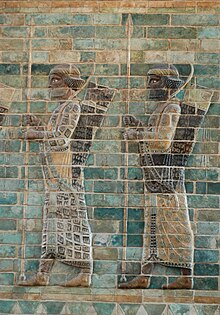Immortals (Persian Empire)
The immortals or the Persian immortals ( Greek : Ἀθάνατοι) formed an elite military unit of the ancient Persian Empire . To date, no Persian source has come down to us in which they were mentioned. Instead, they were named exclusively by Greek historians.
task
Herodotus called the immortals from a military point of view heavy infantry . In peacetime they served as bodyguards of the imperial court and the king, including under Darius I. In the event of war, they formed a kind of standing army . Immortals fought in many wars of the Persian Empire , for example in the campaigns of Cyrus II. 547 BC. BC, those of his son Cambyses II against Egypt (525 BC) and during the invasion of Egypt and Scythia under Dareios I around 520 and 513 BC. Also in the Persian Wars against the Greeks from 480 BC. They took part.
terminology
The term “immortal” in this case does not refer to the individual man; although they represented an elite unit, these troops were by no means optimally armored, compared e.g. B. with hoplites . The unit as a whole is seen much more as immortal, since losses due to death, wounding or illness of the members were immediately offset by reinforcements and so the strength was constantly 10,000.
The term "immortals" was originally coined by Herodotus. However, it is also possible that he confused the Persian words Anûšiya (companions) with Anauša (immortals).
Equipment and training
The unit was equipped with willow shields and short spears , these had a small iron point at their end for better balance and to offer another attack possibility. In the scuffle they also had short swords or daggers , for fights over long distances they carried bows and quivers with them. As clothing they wore a long tunic and linen trousers, under the robe often armor made of overlapping, thin iron plates . They wore a thin fabric tiara on their heads . Often this also covered the face in order to protect it from dust in bad weather, or to intimidate opponents. However, because of their high light transmission, the immortals were still able to see.
The training was far better than that of the Persian light infantry. They received instruction in armed struggle from childhood.
additional
- Under the government of Mohammad Reza Pahlavis , the imperial Iranian guard existed , which, based on the legendary guard, also called itself immortals . It was dissolved after the Islamic Revolution .
- The immortals appear in the feature film The Lion of Sparta .
- In the comic 300 by Frank Miller and in the film adaptation of the comic 300 , the immortals wear masks that are reminiscent of Japanese mempō masks, and swords that are reminiscent of Japanese wakizashi .
swell
- Herodotus : histories. Book 7.
Individual evidence
- ↑ a b Nabil Rastani: The Guards of the Shahanshah, How to fight, carry weapons, ride horses and learn archery. October 27, 2010, accessed October 22, 2014 .
Web links
- Article on monolith.dnsalias.org
